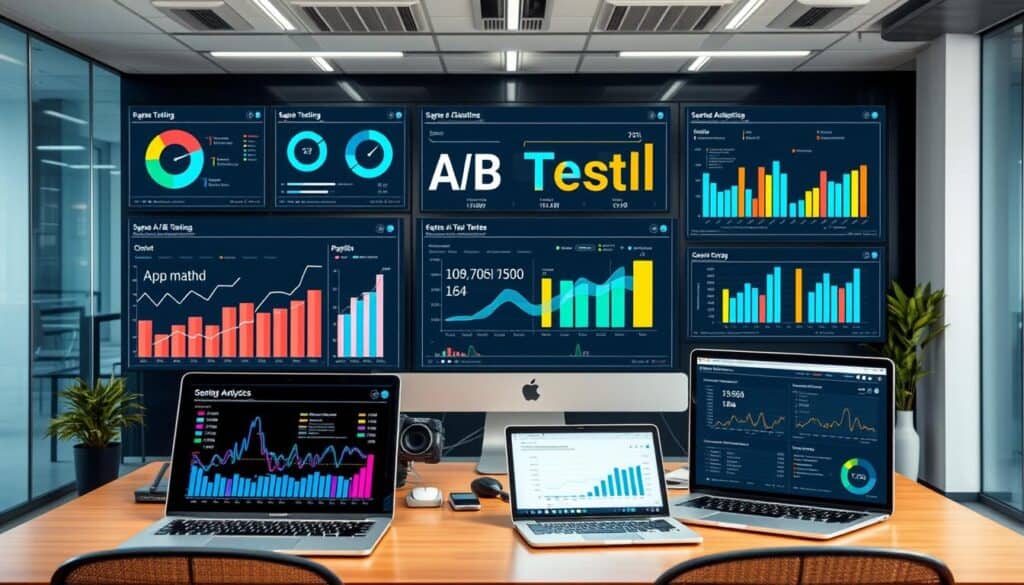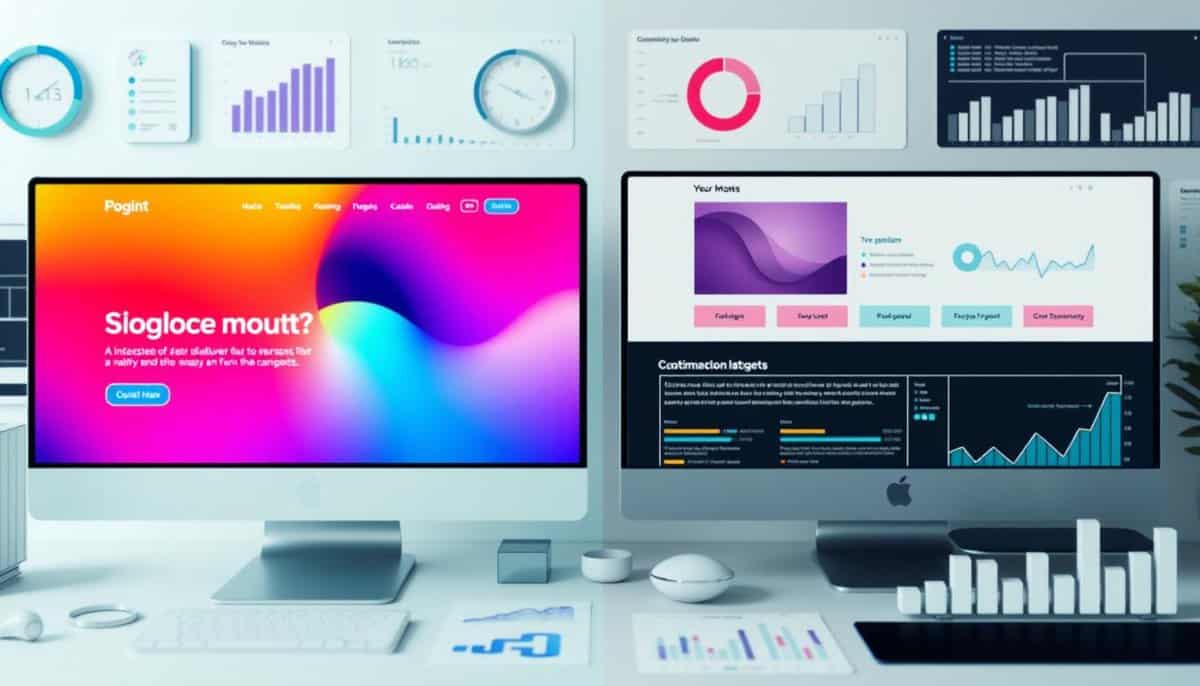Did you know that A/B testing can boost your conversion rates by up to 49%? This fact shows how important A/B testing strategies are. It’s crucial for businesses to use this method. It helps improve website performance and تسويق.
A/B testing, also called split testing, is a key way for companies to make smart choices. It compares two versions of something, like website buttons, to see which is better. This approach improves conversion rates. It removes much of the guesswork in marketing. For example, comparing a blue button to a green button can show which gets more clicks. These insights help create better marketing strategies.
النقاط الرئيسية
- A/B testing strategies can significantly enhance conversion rate optimization and overall website performance.
- Effective marketing techniques are grounded in data-driven decisions derived from A/B testing results.
- A/B testing reduces the risks associated with making changes to products or websites by testing on a smaller scale first.
- Businesses leveraging A/B testing gain a competitive advantage by quickly adapting to market conditions and user preferences.
- Randomization in A/B testing involves assigning users to different groups to ensure unbiased and reliable outcomes.
Introduction to A/B Testing
A/B testing, also known as split testing, helps compare two digital content versions. This method identifies which one performs better. Metrics like click-through rate and conversion rate are used. It’s crucial for creating effective digital marketing strategies.
What is A/B Testing?
A/B testing shows different users two versions of a webpage or app. It measures which one achieves set goals better. For instance, tweaking ad headlines on Bing increased revenue by 12%. This highlights the method’s significant impact.
Tests can vary elements like buttons, headlines, and layouts. Real-time performance monitoring allows for quick changes to enhance results.
Importance of A/B Testing in Digital Marketing
A/B testing is key for improving websites and user experiences in digital marketing. It lets businesses make decisions based on data. This optimizes rates and personalizes user experiences.
Before starting, it’s vital to set clear goals and metrics. Segmenting users helps in understanding and optimizing performances. This leads to better targeting in marketing strategies.
Historical Perspective and Evolution
A/B testing has evolved since the 1990s from simple webpage comparisons. Now, it includes testing multiple variables at once. This evolution emphasizes ongoing testing to better user experiences.
Tools like Fastly’s Compute نطاق make testing easier and quicker. Fastly handles over 1.8 trillion requests daily. Its technology supports sophisticated marketing analytics for stronger strategies.
How to Design an Effective A/B Test
A successful A/B test starts with careful planning and clear goals. It’s important to know what you want to achieve. This should match your business aims and how you measure success (KPIs).
Setting Clear Goals and Objectives
It’s key to define your objectives from the start. Your goal might be to get more website visitors, increase sales, or make users happier. A clear plan keeps your A/B test on track. It helps in building hypotheses and checking if you succeeded.
Formulating Hypotheses
After setting goals, the next task is creating a hypothesis. Making a good hypothesis means guessing how a change will affect user actions. For instance, if you want more clicks, you might think changing your call-to-action (CTA) button makes people interact more. Your content versions must fit the hypothesis being tested.
Choosing Relevant Metrics
Choosing the right metrics is crucial for measuring your test accurately. These metrics should reflect your testing goals. If you aim to boost sales, focus on metrics like the number of sales or sign-ups. Picking suitable metrics makes sure your test results are valid and useful.

| Element | Metrics | Tools |
|---|---|---|
| Website Traffic | Page Views, Unique Visitors | Google Analytics, SimilarWeb |
| Conversion Rates | Completed Purchases, Download Counts | Optimizely, Adobe Target |
| تجربة المستخدم | Average Session Duration, Bounce Rate | Hotjar, UserTesting |
Designing an A/B test needs lots of planning, from goals to hypotheses and choosing metrics. With careful steps, companies can fine-tune strategies for better results and insights.
Types of A/B Testing
A/B testing, or split testing, compares different versions of a webpage or element. It helps see which version does better. It’s not just simple comparisons. There are complex methods like multivariate testing and A/B/C testing. These give deep insights for better conversion strategies.
Split Testing vs. Multivariate Testing
Split testing divides visitors into two groups to see which webpage version gets more conversions. It’s great for testing webpage parts like headlines and images. It gives insights into what the audience likes and helps allocate marketing budgets for better returns.
Multivariate testing looks at many changes at the same time. It allows testing different combinations on the same page. This helps understand how page elements work together, improving conversion strategies.
A/B/C Testing and Beyond
A/B/C testing uses many versions to fully understand how users behave. It’s great for looking at different user actions and how they navigate websites. Tests can vary, like redirect tests which split visitors between pages in ratios like 50/50 or 90/10.
Multi-page funnel A/B tests should keep changes few to get clear results quickly. Through A/B/C testing and more, marketers can make better decisions, reduce site exits, and enhance their websites.
| Testing Type | وصف | Common Applications |
|---|---|---|
| Split Testing (A/B Testing) | Compares two versions of a webpage to determine which one performs better. | Landing pages, email campaigns, and paid ads |
| اختبار متعدد المتغيرات | Tests multiple variables simultaneously to understand their interactions. | Complex webpages with multiple elements like headlines, forms, and images |
| A/B/C Testing | Involves multiple variations to comprehensively understand user behaviors. | Website navigation, multi-page funnel tests |
| Redirect Tests | Allocates visitors between the original and variant pages. | Webpage redesigns, testing new content layouts |
Using different A/B tests, businesses can fine-tune their digital strategies. This ensures more targeted and effective user interactions.
Implementing A/B Tests on Websites
Running A/B tests on websites is essential for companies. They compare two versions to make informed decisions. Using A/B testing tools properly ensures accurate results. These help improve the experience for users and boost conversion rates.
Tool Selection and Setup
Choosing the right A/B testing tools is key. Tools such as Optimizely, VWO, and Google Optimize work well with digital platforms. They let businesses do tests smoothly. Setting them up means adding code to your site and configuring tests. This setup captures and analyzes data well, helping with website optimization techniques.

Randomization and Sample Size
It’s vital to randomize users to avoid bias in results. Assigning users randomly to Version A or B ensures fairness. Also, figuring out the right sample size calculation is critical. The right size makes the results stronger, helping businesses understand user preferences accurately.
Traffic...
You have read 37% of the article. The rest is for our community. Already a member? تسجيل الدخول
(وأيضًا لحماية المحتوى الأصلي لدينا من روبوتات الكشط)
مجتمع الابتكار العالمي
تسجيل الدخول أو التسجيل (100% مجاناً)
اطلع على بقية هذه المقالة وجميع المحتويات والأدوات الخاصة بالأعضاء فقط.
فقط المهندسون والمصنعون والمصممون والمسوقون الحقيقيون المحترفون.
لا روبوت، ولا كاره، ولا مرسل رسائل غير مرغوب فيها.
التعليمات
What is A/B Testing?
A/B testing compares two digital content versions to see which one is better. It uses statistics to make decisions based on data.
Why is A/B Testing important in digital marketing?
A/B testing uses real data to improve digital marketing. It helps improve websites and user experience by showing what changes work best.
How do you design an effective A/B test?
To design a good A/B test, set clear goals and pick the right metrics. This makes sure you get useful results to help your strategy.
What is the difference between Split Testing and Multivariate Testing?
Split testing compares two versions, while multivariate testing looks at many changes at once. They are both used for understanding how to improve conversions but in different ways.
How can A/B testing be applied to physical goods?
For physical products, A/B testing needs a controlled setting. Testing different aspects in stores or online and getting customer feedback helps understand consumer behavior.
What does understanding statistical significance in A/B testing entail?
الفهم statistical significance means using tools like t-tests. These tools show if results are from changes made or just by chance, helping in decision-making.
What are advanced techniques in A/B testing?
Advanced A/B testing techniques include real-time adjustments and using new data in tests. These are valuable for complex tests, making them more effective.
What are common pitfalls in A/B testing and how can they be avoided?
Avoid common mistakes in A/B testing by not ending tests too early. Use proper randomization and analyze data thoroughly to ensure reliable strategies.
How does A/B testing contribute to making data-driven decisions?
A/B testing gives factual data to improve user interaction and conversion rates. This helps businesses make better marketing and product decisions for a competitive edge.
External Links on Product Market Testing
المعايير الدولية
(حرك الرابط لرؤية وصفنا للمحتوى)
Glossary of Terms Used
You have read 37% of the article. The rest is for our community. Already a member? تسجيل الدخول
(وأيضًا لحماية المحتوى الأصلي لدينا من روبوتات الكشط)
مجتمع الابتكار العالمي
تسجيل الدخول أو التسجيل (100% مجاناً)
اطلع على بقية هذه المقالة وجميع المحتويات والأدوات الخاصة بالأعضاء فقط.
فقط المهندسون والمصنعون والمصممون والمسوقون الحقيقيون المحترفون.
لا روبوت، ولا كاره، ولا مرسل رسائل غير مرغوب فيها.
What is A/B Testing?
A/B testing compares two digital content versions to see which one is better. It uses statistics to make decisions based on data.
Why is A/B Testing important in digital marketing?
A/B testing uses real data to improve digital marketing. It helps improve websites and user experience by showing what changes work best.
How do you design an effective A/B test?
To design a good A/B test, set clear goals and pick the right metrics. This makes sure you get useful results to help your strategy.
What is the difference between Split Testing and Multivariate Testing?
Split testing compares two versions, while multivariate testing looks at many changes at once. They are both used for understanding how to improve conversions but in different ways.
How can A/B testing be applied to physical goods?
For physical products, A/B testing needs a controlled setting. Testing different aspects in stores or online and getting customer feedback helps understand consumer behavior.
What does understanding statistical significance in A/B testing entail?
الفهم statistical significance means using tools like t-tests. These tools show if results are from changes made or just by chance, helping in decision-making.
What are advanced techniques in A/B testing?
Advanced A/B testing techniques include real-time adjustments and using new data in tests. These are valuable for complex tests, making them more effective.
What are common pitfalls in A/B testing and how can they be avoided?
Avoid common mistakes in A/B testing by not ending tests too early. Use proper randomization and analyze data thoroughly to ensure reliable strategies.
How does A/B testing contribute to making data-driven decisions?
A/B testing gives factual data to improve user interaction and conversion rates. This helps businesses make better marketing and product decisions for a competitive edge.
External Links on Product Market Testing
المعايير الدولية
(حرك الرابط لرؤية وصفنا للمحتوى)
Computed Tomography (CT): تقنية تصوير طبي تستخدم الأشعة السينية والمعالجة الحاسوبية لإنشاء صور مقطعية للجسم، مما يتيح تصورًا دقيقًا للهياكل والأنسجة الداخلية. تُعزز هذه التقنية قدرات التشخيص من خلال توفير صور ثلاثية الأبعاد من بيانات ثنائية الأبعاد.
Key Performance Indicator (KPI): قيمة قابلة للقياس توضح مدى فعالية المنظمة في تحقيق الأهداف التجارية الرئيسية، وغالبًا ما تستخدم لتقييم النجاح في الوصول إلى الأهداف.
User experience (UX): الرضا العام والإدراك لدى المستخدم عند التفاعل مع منتج أو نظام أو خدمة، بما في ذلك قابلية الاستخدام وإمكانية الوصول والتصميم والاستجابة العاطفية طوال عملية التفاعل بأكملها.











Does anyone else think A/B testing could potentially lead to decision paralysis in marketing teams?
Interesting read, but dont you think relying solely on A/B testing might limit creative strategy in digital marketing?
التعليقات مغلقة